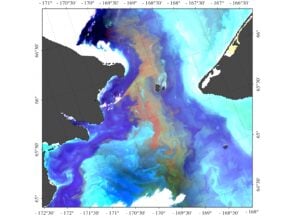A summer 2022 research cruise that detected a massive and highly toxic harmful algal bloom (HAB) in the Bering Strait has provided a dramatic example of science that utilized new technology to track a neurotoxic HAB and effectively communicate that information in real time to protect remote communities in coastal Alaska.
The massive spatial scale, high cell density, long duration and potent toxicity of the 2022 HAB event “posed an unprecedented risk to human and ecosystem health as well as harvest activities in the Bering Strait region and beyond,” according to the journal article “Tracking a large-scale and highly toxic Arctic algal bloom: rapid detection and risk communication,” published in Limnology and Oceanography Letters.
With many coastal Alaskan communities relying on marine resources for subsistence and commercial activities, researchers and collaborators distributed risk advisories to tribal governments, regional media and the public shortly after the 2022 bloom was detected. The efforts “mobilized a rapid and unprecedented regional response in an area with little experience of [harmful algal blooms], much less one of this magnitude,” the researchers noted.
Researchers additionally noted that, to their knowledge, the 2022 event was the largest bloom ever documented in polar waters of the single-celled organism Alexandrium catenella, which produces neurotoxins called paralytic shellfish toxins. These toxins accumulate in organisms that consume the algae, are transferred through the food web causing illness or mortality of marine organisms and paralytic shellfish poisoning in people who eat contaminated seafoods.
The journal article notes:
“As continued warming shifts the Pacific Arctic towards more favorable conditions for A. catenella blooms, comprehensive monitoring and response resources will be essential in mitigating the impacts of future bloom events.”
According to lead author Evie Fachon:
“A goal of this study is to bring more attention to some of the serious issues this region is facing, knowing that as climate changes and the Arctic continues to warm, it’s more likely that we are going to see blooms like this occurring in polar waters. We are hopeful that this research can motivate more robust testing and monitoring.”
(Featured Image credit: Priscila Lange, ©Bigelow Laboratory for Ocean Sciences and Universidade Federale Rio de Janeiro)
>>> Read full article>>>
Copyright for syndicated content belongs to the linked Source : DeeperBlue – https://www.deeperblue.com/a-massive-dangerous-algal-bloom-in-the-arctic-prompted-real-time-health-advisories-to-western-alaskan-communities/































